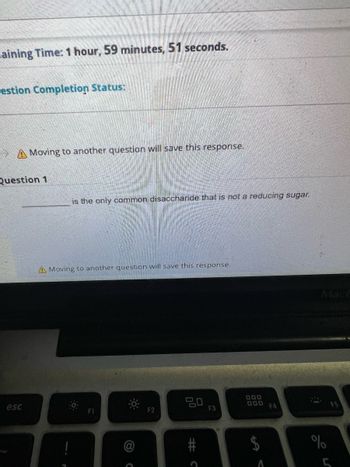
Chemistry
10th Edition
ISBN: 9781305957404
Author: Steven S. Zumdahl, Susan A. Zumdahl, Donald J. DeCoste
Publisher: Cengage Learning
expand_more
expand_more
format_list_bulleted
Concept explainers
Question

Transcribed Image Text:aining Time: 1 hour, 59 minutes, 51 seconds.
estion Completion Status:
Moving to another question will save this response.
Question 1
esc
is the only common disaccharide that is not a reducing sugar.
A Moving to another question will save this response.
F1
C
F2
ㅁㅁ
#C
F3
000
000
$
F4
1:
%
F5
5
Expert Solution
This question has been solved!
Explore an expertly crafted, step-by-step solution for a thorough understanding of key concepts.
Step by stepSolved in 2 steps

Knowledge Booster
Learn more about
Need a deep-dive on the concept behind this application? Look no further. Learn more about this topic, chemistry and related others by exploring similar questions and additional content below.Similar questions
- A glycosidic bond connects two monosaccharides to create sucrose (more commonly known as table sugar). Identify the type of glycosidic bond connecting the monosaccharides together as well as these two monosaccharides that are found in sucrose. a. α,ß-1,2-glycosidic bond, ß-L-glucose, and α- L-fructose b. α,ß-1,2-glycosidic bond, α-D-galactose, and ß-D-glucose c. α-1,4-glycosidic bond, α-D-glucose, and ß-D-fructose d. α,ß-1,2-glycosidic bond, α-D-glucose, and ß-D-fructosearrow_forwardI need help solving this problem. Especially when identifying the linkages for the two disaccharides on the left-hand side.arrow_forwardA monosaccharide is __________. a. a simple sugar containing three or more carbons b. a carbohydrate with higher molecular weight than a disaccharide c. made from amine (−NH2) and carboxylic acid (−COOH) functional groups d. a large biological molecule consisting of one or more chains of amino acidsarrow_forward
- 2.Complete these word equations. (product /examples) a. (monosaccharide)n b. Glucose + Glucose c. Lactose + Hydrolysis d. Non-reducing Disaccharide + Hydrolysis =arrow_forwardThe disaccharide maltose is shown below. It contains an a-1,4'-glycosidic linkage between two sugars. Number the carbons on each using the correct numbering scheme for sugars (the sugar on the right should be numbered 1', 2', 3', etc.). Circle the glycosidic bond. Name the two monosaccharides that make up maltose. OH Sugar 1 (left): Sugar 2 (right): Type of glycosidic bond: но- HO Sugar: Type of glycosidic bond: HO- Sugar 1 (left): Sugar 2 (right): Name the two monosaccharides that comprise lactose (shown below). Number the carbons. Name the type of glycosidic bond. HOOH OH НО HO HO- OH OH HO- Name the monosaccharide and the type of glycosidic bond in the polysaccharide galactan shown below. OH НОО OH HO- OH OH OH OHarrow_forward2. Consider the following disaccharide: CH₂OH OH OH OH CH₂OH HO OH CH₂OH a. Provide the name of this sugar and name the monosaccharide(s) it is derived from. b. What type of glycosidic bond is present in this sugar? c. Is this a reducing sugar? Explain.arrow_forward
- For the disaccharide shown below answer the following questions. CH,OH H H H OH H НО H ОН HOCH, OH CH2OH H OH H a. Identify this disaccharide. Do not worry about alpha, beta, D or L notation. b. What type of glycosidic bond links the monosaccharide units together? Be sure to include alpha, beta, and numbers if appropriate and in the correct order. c. Write the names of the two monosaccharide units produced by hydrolysis of this disaccharide. Be sure to include alpha, beta, and D appropriately in the names and in the correct order.arrow_forward9. Which of the following descriptions apply to a disaccharide but not a monosaccharide? A. The molecule can have an acyclic structure. B. There is a glycosidic bond. C. An anomeric carbon can determine the a or ß structure. D. The molecule is soluble in water. E. None of these statements apply to a disaccharide but not a monosaccharide. 10. Where are the carbohydrates formed that our bodies need? A. Our body's liver B. In animal tissue C. By plants D. In the body's adrenal glands E. None of thesearrow_forwarda. State the type of glycosidic bond that is present in the disaccharide shown below. b. Is the disaccharide shown below a reducing sugar (Yes or No)? Explain why writing complete sentences. CH2OH CH2OH H H H H OH H ОН Н ОН Н НО H H OH H ОНarrow_forward
- The most common polysaccharides Found in plants and animals are polymers of? galactose glucose fructose glucose and fructosearrow_forwardLooking at the molecular formula for sucrose. Why does this carbohydrate not follow the 1:2:1 carbon to hydrogen to oxygen ratio of monosaccharide? What other carbohydrates would not follow this ratio?arrow_forward6. In the blanks below, create at least 3 disaccharides by showing which monosaccharides bond:arrow_forward
arrow_back_ios
SEE MORE QUESTIONS
arrow_forward_ios
Recommended textbooks for you
 ChemistryChemistryISBN:9781305957404Author:Steven S. Zumdahl, Susan A. Zumdahl, Donald J. DeCostePublisher:Cengage Learning
ChemistryChemistryISBN:9781305957404Author:Steven S. Zumdahl, Susan A. Zumdahl, Donald J. DeCostePublisher:Cengage Learning ChemistryChemistryISBN:9781259911156Author:Raymond Chang Dr., Jason Overby ProfessorPublisher:McGraw-Hill Education
ChemistryChemistryISBN:9781259911156Author:Raymond Chang Dr., Jason Overby ProfessorPublisher:McGraw-Hill Education Principles of Instrumental AnalysisChemistryISBN:9781305577213Author:Douglas A. Skoog, F. James Holler, Stanley R. CrouchPublisher:Cengage Learning
Principles of Instrumental AnalysisChemistryISBN:9781305577213Author:Douglas A. Skoog, F. James Holler, Stanley R. CrouchPublisher:Cengage Learning Organic ChemistryChemistryISBN:9780078021558Author:Janice Gorzynski Smith Dr.Publisher:McGraw-Hill Education
Organic ChemistryChemistryISBN:9780078021558Author:Janice Gorzynski Smith Dr.Publisher:McGraw-Hill Education Chemistry: Principles and ReactionsChemistryISBN:9781305079373Author:William L. Masterton, Cecile N. HurleyPublisher:Cengage Learning
Chemistry: Principles and ReactionsChemistryISBN:9781305079373Author:William L. Masterton, Cecile N. HurleyPublisher:Cengage Learning Elementary Principles of Chemical Processes, Bind...ChemistryISBN:9781118431221Author:Richard M. Felder, Ronald W. Rousseau, Lisa G. BullardPublisher:WILEY
Elementary Principles of Chemical Processes, Bind...ChemistryISBN:9781118431221Author:Richard M. Felder, Ronald W. Rousseau, Lisa G. BullardPublisher:WILEY

Chemistry
Chemistry
ISBN:9781305957404
Author:Steven S. Zumdahl, Susan A. Zumdahl, Donald J. DeCoste
Publisher:Cengage Learning

Chemistry
Chemistry
ISBN:9781259911156
Author:Raymond Chang Dr., Jason Overby Professor
Publisher:McGraw-Hill Education

Principles of Instrumental Analysis
Chemistry
ISBN:9781305577213
Author:Douglas A. Skoog, F. James Holler, Stanley R. Crouch
Publisher:Cengage Learning

Organic Chemistry
Chemistry
ISBN:9780078021558
Author:Janice Gorzynski Smith Dr.
Publisher:McGraw-Hill Education

Chemistry: Principles and Reactions
Chemistry
ISBN:9781305079373
Author:William L. Masterton, Cecile N. Hurley
Publisher:Cengage Learning

Elementary Principles of Chemical Processes, Bind...
Chemistry
ISBN:9781118431221
Author:Richard M. Felder, Ronald W. Rousseau, Lisa G. Bullard
Publisher:WILEY